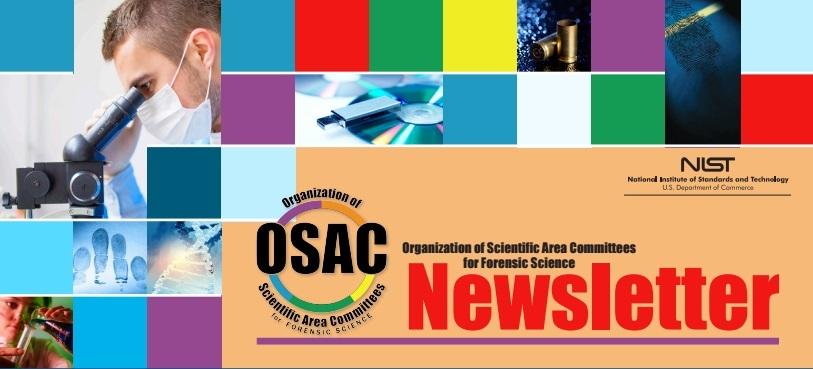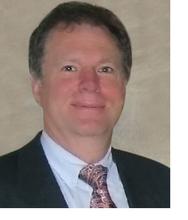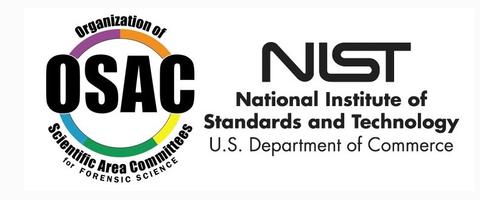OSAC Newsletter, July 2016

July 2016
Nurturing Disparate Disciplines in a Long-Neglected Profession | First Interdisciplinary Standards Open for Public Comment through July 21, 2016 | Message from the FSSB: Joint OSAC FSSB and NIST Statement on ASTM E2329-14 | On the Horizon | REMINDER: Access to ASTM Committee E30 on Forensic Science's Standards are Available at No-Cost to OSAC Members and Affiliates and Certain OSAC Stakeholders
Nurturing Disparate Disciplines in a Long-Neglected Profession
BY DAVID STONEY, Chief Scientist at Stoney Forensic, member of the OSAC Physics/Pattern Scientific Area Committee

If we were to step back a bit to get a perspective on OSAC, we'd have to get pretty far away. In fact, if we were to view it from above we'd be at a dizzying height. "A collaborative body of more than 500 forensic science practitioners and other experts who represent local, state, and federal agencies; academia; and industry." We are a bit larger, and considerably more diverse in profession, than the United States Congress. If we find ourselves frustrated over the progress of our documents, coordination of our efforts, accommodating different points of view, or anything else, we might well reflect on the efforts of our representatives on Capitol Hill.
The forensic science profession in the United States developed without coordination, across hundreds of jurisdictions, and over more than a century, in response to meeting explicit needs of law enforcement and the courts. While showing many components of a mature profession, its academic component has remained rudimentary, failing (despite notable individual efforts) to provide leadership and fundamental development for the profession. Working for decades within this void, and virtually ignored by the legal and broader scientific communities, practitioners bore responsibility for development of the forensic sciences.
That period is clearly behind us. We now have everybody's attention and, not surprisingly, there are plenty of gaps to fill. OSAC fits within this context, remarkable for its size, its structure and its membership. For the first time the broader scientific community, legal community and forensic science critics are meaningfully engaging with forensic scientists. Likewise, for the first time, the diverse forensic science disciplines are engaging with one another. OSAC has brought this about within a structure that keeps practitioners largely in control, but requires meaningful interactions, consideration of progressive views, and standardization across disciplines. Following decades of benign neglect, it is a fruitful time for improvements in forensic sciences; expectations are high and the range of possible contributions, paralleling the diverse capabilities of our membership, is extraordinarily broad.
Amidst this great potential, our greatest challenge is the management of frustration – and there is necessarily considerable frustration. It could not be otherwise. Other professions have grown gradually, with practitioners adjusting to new ideas, academic contributions and opposing views over many years. We are condensi

ng this process, simultaneously seeking contributions from many perspectives, and practitioners cannot help but feel frustrated and nearly overwhelmed. At the same time, other OSAC members with challenging views and meaningful contributions (often obvious within their own disciplines) find it frustrating to work with a profession that has developed empirically, and whose primary experience with scientific criticism has been in a confrontational and unforgiving legal arena.
The maintenance of our enthusiasm for this process is critically important. OSAC is a volunteer organization and we need all components of OSAC to work together. Accepting our frustration and keeping a proper perspective on this remarkable effort will help us recognize that small gains, along with the guarantee of continuing iterative improvements, will result in steady, and ultimately revolutionary, progress.
First Interdisciplinary Standards Open for Public Comment Through July 21, 2016

Two standards were submitted by one OSAC Virtual Interdisciplinary Subcommittee (consisting of representatives from all OSAC subcommittees) for consideration to the OSAC Registry of Approved Standards.
ISO/IEC 17025:2005 General Requirements for the Competence of Testing and Calibration Laboratories (for consideration as an OSAC Standard)
ISO/IEC 17025:2005 specifies the general requirements for the competence to carry out tests and/or calibrations, including sampling. It covers testing and calibration performed using standard methods, non-standard methods, and laboratory-developed methods.
It is applicable to all organizations performing tests and/or calibrations. These include, for example, first-, second- and third-party laboratories, and laboratories where testing and/or calibration forms part of inspection and product certification.
ISO/IEC 17020:2012 Requirements for the Operation of Various Types of Bodies Performing Inspection. (for consideration as an OSAC Standard)
ISO/IEC 17020:2012 specifies requirements for the competence of bodies performing inspection and for the impartiality and consistency of their inspection activities.
It applies to inspection bodies of type A, B or C, as defined in ISO/IEC 17020:2012, and it applies to any stage of inspection.
While these standards are already widely implemented and used in the domestic and international forensic science community, the majority of the virtual subcommittee voted to move these forward for consideration, believing that adding these to the registry would broaden the impact of these standards by:
o Promoting and facilitating technical competence and valid test and inspection results
o Encouraging all forensic science service providers to implement the standards, (including smaller laboratories and crime scene units)
o Offering the incentive for smaller laboratories and crime scene units to seek the funding and personnel they need to implement them.
The public comment period is open on the OSAC Kavi Public Workspace under "Documents". The intent of the public comment period is to collect public opinion on inclusion of the standards to the OSAC registry (OSAC is not soliciting potential revisions to the documents themselves.)
Message from the FSSB: Joint OSAC FSSB and NIST Statement on ASTM E2329-14

On Jan. 11, 2016, the OSAC Forensic Science Standards Board (FSSB) voted to elevate ASTM Standard E2329-14 "Standard Practice for Identification of Seized Drugs" to the OSAC Registry of Approved Standards. The standard is used by forensic laboratories as a protocol for testing seized drug evidence to determine if drugs of abuse such as cocaine or heroin are present. This is the first standard posted to the registry.
ASTM E2329-14 contains the following sentence: "It is expected that in the absence of unforeseen error, an appropriate analytical scheme effectively results in no uncertainty in reported identifications." The FSSB and NIST agree that the term "effectively results in no uncertainty" means different things to different readers of the document. While this language was deemed appropriate by its authors, it was deemed inappropriate by others including NIST. Consequently, NIST, OSAC, and ASTM have agreed to work together on new language that conveys clear meaning. This process is expected to take approximately 6 months. The OSAC will consider the revised ASTM document as quickly as possible for updating the current document on the registry. It is important to note that the concern over ASTM E2329 is in regards to the specific language used in the standard; neither the FSSB nor NIST is contesting the analytical results obtained from seized evidence using the standard.
NIST and the FSSB will continue to work together on OSAC process improvements to help ensure consistently high quality scientific reviews of documentary standards that the forensic science community can endorse as trusted, valuable resources.

(OSAC Meetings for OSAC Members and Invited Guests) The next full OSAC meetings are scheduled for summer 2016 in Phoenix, AZ. Instead of meeting as one large group, the OSAC will meet separately in a series of smaller meetings.
o (OSAC Meeting Breakout #2) Digital/Multimedia SAC + 4 Subcommittees, Physics/Pattern SAC + 5 Subcommittees, Jul 26-29, 2016
o (OSAC Meeting Breakout #3) Chemistry SAC + 6 Subcommittees, Aug 2-5, 2016
o (OSAC Meeting Breakout #4) Biology/DNA SAC + 3 Subcommittees, and Crime Scene SAC + 7 Subcommittees, Aug 23-26, 2016
o (OSAC Meeting for OSAC Members and Invited Guests) The following full OSAC meeting is scheduled for April 3-7, 2017, tentatively in Leesburg, VA.
o OSAC public meeting date and times will be announced shortly.
Upcoming Events at NIST of Potential Interest to OSAC Stakeholders:
• Trace Evidence Data Workshop: Improving Technology and Measurement in Forensic Science, July 19-20, 2016. This event is a part of an effort at NIST to gather feedback from the practitioners and researchers in the forensic science community on further improving access and expanding the development of datasets useful, specifically, for trace forensic evidence. Visit the Trace Evidence Data Workshop page.
The Organization of Scientific Area Committees (OSAC) for Forensic Science through the National Institute of Standards and Technology (NIST) has entered into a contract with ASTM International to enable 30,000 public criminal justice agencies to receive free access to ASTM's Committee E30 on Forensic Science Standards. This agreement provides access to approximately 48 existing standards under the jurisdiction of E30 and future standards developed during the period of performance. The NIST agreement consists of a base year that began on March 15, 2016, and an option to extend the agreement for an additional year. The specific stakeholders who will receive free unlimited web-based access are as follows:
· OSAC Members & Affiliates – approximately 750 individuals
· NIST and Federal/State/Local Crime Laboratories – approximately 412 laboratories
· Public Defender Offices – approximately 6,000 offices
· Law Enforcement Agencies – approximately 18,000 offices
· Prosecutor Offices – approximately 3,000 offices
· Medical Examiner/Coroner Offices – approximately 3,000 offices
Public sector criminal justice agency employees in the stakeholder groups listed above are eligible for free access to all ASTM Committee E30 on Forensic Science Standards. Once users enter the ASTM Compass website, they can begin searching by standard number, title, or keyword. To see a complete list of standards included in this collection, click on "Custom Collection" on the left side of the page. Since the launch in February, 100 users have created accounts to access the collection and there have been over 900 downloads of specific ASTM documents.

